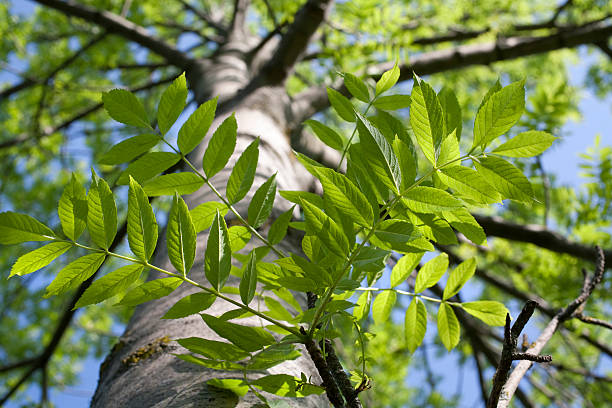Written by Admin and published on https://www.bioadvanced.com/
The borer kills a tree by creating tunnels as they eat through the tree’s nutrient-conducting tissues. They destroy the channels that transport water from the tree’s roots to its leaves, as well as the sugars produced in photosynthesis flowing from the leaves to the roots. Once attacked, small trees may die within 1-2 years of becoming infested and large trees can be killed in 3-4 years. If caught early enough, infested ash trees can be treated and protected.
Homeowners should monitor their ash trees for signs and symptoms of EAB. One of the first signs is canopy dieback of the upper branches. If left untreated, the tree will die. If the ash tree still looks healthy, the time to protect the tree is now. Once it’s in decline, it may be too late. Either way, there is a cost to treat a live tree or removing a dead one.
Protect Your Ash Tree
Identifying Ash Trees
Before you can determine if you have an Emerald Ash Borer (EAB) problem, you must first identify whether or not you have Ash trees. Use these common criteria for identifying Ash.
Leaves
Ash trees feature compound leaves made of 5-11 leaflets. Ash leaves also have opposite budding, with leaflets being directly across from each other.
Branches
Like their leaves, Ash tree branches are also directly across from each other – not staggered.
Bark
Young Ash trees will have relatively smooth bark, while mature trees will have tight bark featuring distinct diamond-shaped ridges.
Seeds
When present, Ash tree seeds will usually be clustered together as dry, oar-shaped samaras.
Signs Of Infestation
Here are some helpful tips on what to look for in your Ash trees for signs of stress and infestation.
Emerald Ash Borer (EAB) Adult
Metallic green-colored adults emerge in early summer to feed on Ash foliage and lay eggs on bark. Little noticeable damage is caused by EAB adults.Photograph by Leah Bauer, USDA Forest Service Northern Research Station, Bugwood.org
EAB Larvae
Eggs hatch into larvae during late summer and fall. Larvae tunnel into trees to feed under the bark, thereby destroying the tree’s ability to transport water and nutrients. Larvae leave S-shaped galleries under the bark of the trunk and branches. Photograph: Pennsylvania Department of Conservation and Natural Resources – Forestry Archive, Bugwood.org
The Next Year
Larvae spend the winter under the bark, pupate into adults, and emerge in early summer. As the adults exit the tree, they leave behind D-shaped exitholes. Eggs are laid soon thereafter and the destructive cycle begins again. Photograph by David Cappaert, Michigan State University, Bugwood.org
Check Your Ash Trees For Signs Of Stress
Can Your Ash Tree Be Saved?
Healthy trees can still be saved from EAB. Follow these easy steps to help you identify if your Ash trees can be treated with BioAdvanced Tree and Shrub product line.
Are your trees:
- Healthy and growing with more than half their leaves
- Less than 20″ in diameter at chest height
- Showing only few outward signs such as woodpecker damage, bark splits and water sprouts at the tree base
If your tree fits these criteria, 12 Month Tree & Shrub Protect & Feed may be for you. If your tree doesn’t fit these criteria, contact a certified arborist in your area. Photograph David Cappaert,Michigan State University, Bugwood.org
Protect And Feed Your Trees
- Use 12 Month Tree & Shrub Protect & Feed Liquids to keep your Ash trees healthy and happy
- Provides 12 months of systemic protection with one application
- Provides slow-release fertilizer
- Protects entire tree or shrub – especially new growth
- Prevents damage from destructive insects like Emerald Ash Borers, Japanese Beetles (Adult), Leafminers and other listed pests
- Just measure, mix and water in
Original post here https://www.bioadvanced.com/articles/protect-your-ash-trees/.


